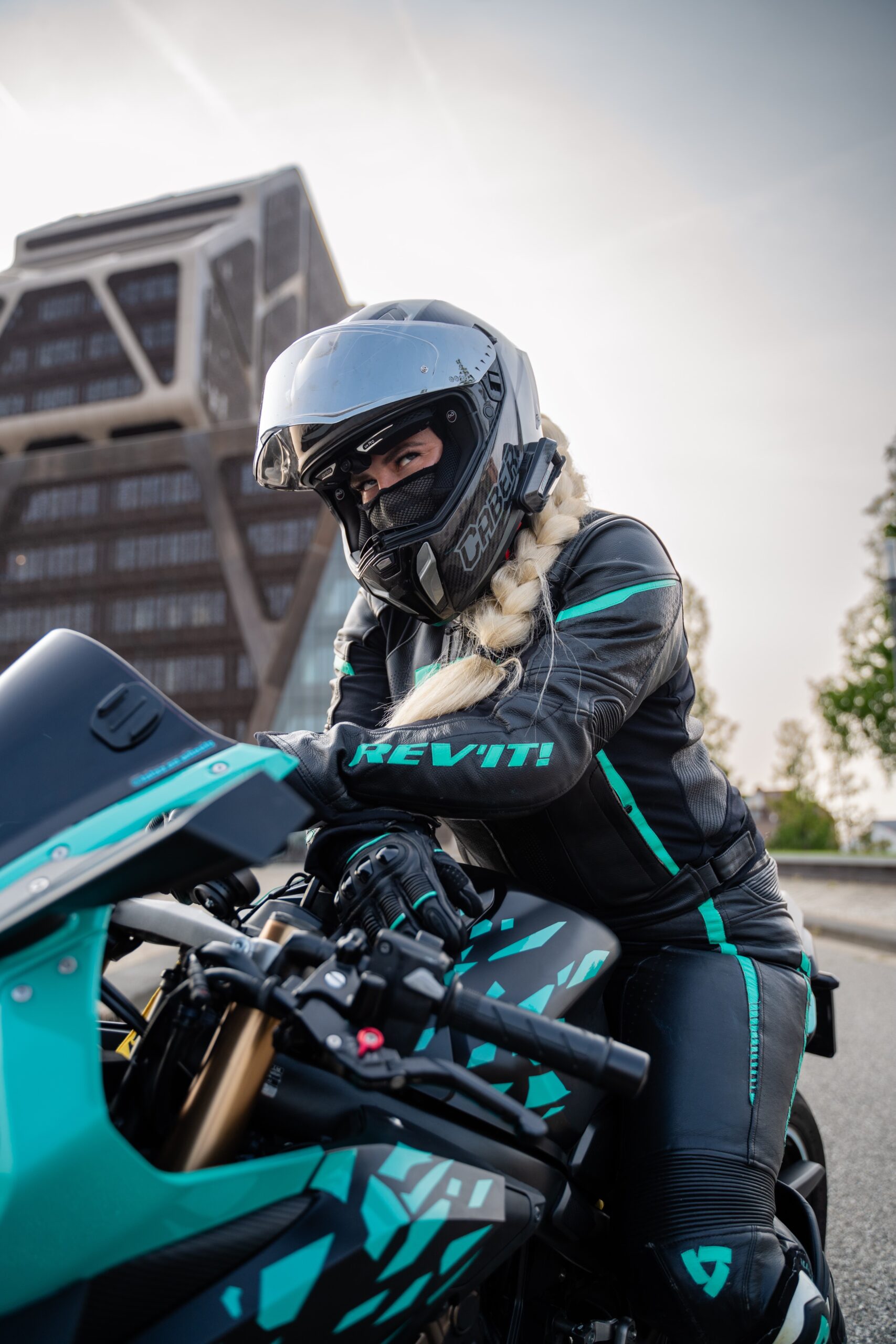28/08/2024
Reading time: 6 minutes
Motorcycle safety has become a major priority in light of recent road safety statistics. Indeed, according to road safety data, in 2020, motorized two-wheelers accounted for only 2% of traffic but 34% of serious injuries on the road, highlighting the vulnerability of two-wheeled vehicles.
But in this article, we’re not talking about the mandatory gear that everyone already knows, like wearing a helmet—of course, that’s essential. No, here we’re mentioning some accessories you might not have thought of, or at least that aren’t as obvious. Think of them as a series of small tips that could save your life… or your motorcycle!
Sommaire
The smart motorcycle airbag vest
This safety equipment is becoming increasingly common among motorcyclists. Unlike a more traditional airbag vest, the connected version doesn’t just activate in the event of a violent impact. It’s equipped with sensors capable of detecting the early signs of a fall, such as a sudden change in tilt or significant deceleration. Within milliseconds, a system inflates an air chamber inside the vest, providing effective protection around the chest and abdomen.
The benefits of a smart airbag vest for motorcyclists
This safety device offers additional protection to the traditional motorcyclist’s gear (helmet, gloves, etc.). In the event of a fall, it significantly reduces the risk of serious injuries to the chest, abdomen, and spine—areas that are particularly vulnerable in a crash.
Advantages include:
- Optimal protection of vital areas: The vest inflates quickly, forming an effective barrier against impacts, thereby reducing internal injuries.
- Comfort and discretion: Most of these vests are discreet and comfortable to wear under a motorcycle jacket.
- Advanced technology: Recent models are equipped with increasingly efficient sensors, offering more precise fall detection.
- Adaptability:Airbag vests come in different sizes and can be adapted to all body types.
How to choose one?
Choosing this kind of equipment is an important decision that requires careful thought. To select the model that best suits you, it’s crucial to consider your riding habits, your body type, and the features offered. An airbag vest should fit your body perfectly and provide optimal protection for vital areas. Don’t hesitate to prioritize models certified by recognized organizations, as this is a guarantee of quality and safety.
Regular maintenance of your airbag vest is essential to ensure its longevity and effectiveness. Avoid machine washing it, and follow the manufacturer’s recommendations.
Additionally, your vest should be inspected by a professional every two or three years to detect any potential issues.
Finally, it’s important to be aware of the regulations in your country regarding the use of motorcycle airbag vests. Some countries have implemented specific requirements, particularly for young riders. Ensure that your airbag vest complies with current standards and check with your insurer if wearing this equipment might affect your insurance premium.
Motorcycle helmet rear lights: this small blinking light attaches to your helmet, making you more visible, especially in low-light conditions.
Every morning in urban areas, we see cyclists with blinking lights on their helmets. Well, guess what? Similar accessories exist for motorcyclists.
The rear helmet light is a small accessory that can greatly enhance your safety on a motorcycle. By attaching it to the back of your helmet, it makes you much more visible, especially in low-light conditions or unfavorable weather.
What’s it for?
To enhance your safety, just like the other accessories on this list.
This blinking light makes you more noticeable. Positioned higher than the motorcycle’s brake light and turn signals, it complements them by making you visible from a distance or when another vehicle obstructs the view of your motorcycle, for example. This is particularly crucial in urban areas, where traffic is dense and blind spots are common. Some models with brake or turn signals provide other drivers with clearer information about your actions (or future actions), allowing them to better anticipate.
This device significantly reduces the risk of accidents, particularly those related to inattention, blind spots, or rear-end collisions during sudden braking or lane changes.
How to choose your helmet rear light?
When choosing your helmet rear light, several criteria should be considered. First, ensure that its battery life is sufficient to last throughout your trips.
Next, various options exist depending on the model, such as fixed/blinking mode or brake light function. Some even allow you to adjust the brightness based on the weather and time of day. This maximum brightness should be strong enough to be visible from a distance, even in daylight. Finally, it should be weather-resistant to ensure a long lifespan.
Check all this information with the seller before purchasing and also confirm that it’s compatible with your helmet model.
Motorcycle tire pressure monitoring system (TPMS)
This technology is standard on all modern cars but isn’t yet as widespread for two-wheelers, though manufacturers are starting to adopt it.The good news is that you can get a device to install on your handlebars that monitors your tire pressure in real-time and alerts you if it drops, helping you avoid losing grip or stability.
What’s it for?
There are two types of TPMS:
Direct TPMS : The sensors are integrated into the tire valves. They continuously measure pressure and temperature, sending the data to a receiver on the handlebars.
Indirect TPMS: This system uses ABS data to detect differences in wheel rotation, thus inferring if a tire is underinflated. It’s less accurate than direct TPMS but is cheaper.
How to choose your TPMS?
Choosing a tire pressure monitoring system isn’t always a straightforward task. Beyond the differences between direct and indirect systems, not all TPMS are created equal: sensor accuracy, ease of installation, battery life, compatibility with various motorcycle types… there are many criteria and comparison points to consider. Nevertheless, by prioritizing a model known for its reliability and offering a clear display, you’ll not only ensure safe riding but also extend the life of your tires and reduce fuel consumption. As always, don’t hesitate to consult reviews from other bikers to make sure you choose the option best suited to your needs and budget.
Photochromic visor
This is another technological innovation capable of adapting to the environment. Photochromic visors change their tint almost instantly depending on the external light conditions. At night, they’re completely clear; on cloudy days, a light filter is applied; and in full sunlight, they become very dark. This technology has been used by eyewear manufacturers for decades, and more recently, helmet manufacturers have incorporated it into visor design.
What’s it for?
This equipment ensures you’re never blinded when exiting a tunnel, for example, which could prevent you from crashing into the vehicle in front of you (among other things). It’s an intelligent blend of other visor types. The human eye needs between 5 and 10 seconds to adjust to light changes; on the road, 5 seconds of blindness can have dramatic consequences (for instance, at 90 km/h, you cover 135 meters in 5 seconds). Moreover, it protects your eyes from UV rays… a bonus!
How to choose your visor?
This choice will largely depend on your budget, with prices ranging from around €100 to €250 for the Shadow model. Obviously, it’s recommended to avoid low-priced products offered on certain mass-marketplaces known for their poor-quality products.
There’s also an anti-fog option available on some photochromic visors, making it the ultimate visor.
Cambox helmet camera: record your rides with a total peace of mind
The Cambox helmet camera is an action camera that attaches directly inside the helmet, behind the visor.

Why use a helmet camera?
If you often ride a motorcycle, you may have already experienced an unfortunate situation: accidents, incivilities, or even assaults can occur almost anytime on the road. So, having video and audio evidence of the events in case of disputes can be extremely valuable. Moreover, offering discounts on premiums to insured riders who equip themselves with a camera is a growing practice among insurers.
Owning a camera and knowing that all your actions are being recorded also helps to encourage responsible riding and prevent risky behavior.
Wearing a camera also deters other road users from committing offenses like assaults or thefts, as they know they’re being filmed and risk being identified and prosecuted.
Finally, the Cambox allows you to capture memories and share your best motorcycle rides, which is always fun.
A positioning that ensures your safety
With a Cambox, there’s no need to add a rigid mounting system to your helmet that could be dangerous in a crash (just ask Schumacher). The camera is placed inside the helmet, behind the visor, with a double Velcro® system. None of our users who have crashed while wearing the Cambox have suffered additional injuries due to the camera.
A unique perspective
It records everything you see! The lens is positioned right between your eyes, so the camera follows your gaze. If you look to the left, you film to the left without even thinking about it. This way, it doesn’t miss anything and provides evidence of your actions… or what you couldn’t see. It’s true POV in the strict sense of the term; it’s hard to get more immersive than that!
So, to learn more about our world-unique cameras, click here.
Next article :




